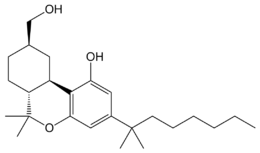HU-243
Tools
Actions
General
Print/export
In other projects
Appearance
From Wikipedia, the free encyclopedia
This is an old revision of this page, as edited by EdChem (talk | contribs) at 14:56, 1 August 2016 (unit spacing and italicise). The present address (URL) is a permanent link to this revision, which may differ significantly from the current revision.
 | |
| Identifiers | |
|---|---|
| |
| CAS Number | |
| PubChem CID | |
| IUPHAR/BPS | |
| CompTox Dashboard (EPA) | |
| Chemical and physical data | |
| Formula | C25H40O3 |
| Molar mass | 388.30 g/mol g·mol−1 |
| 3D model (JSmol) | |
| |
HU-243 (AM-4056) is a synthetic cannabinoid drug that is a single enantiomer of the hydrogenated derivative of the commonly used reference agonist HU-210. It is a potent agonist at both the CB1 and CB2 receptors, with a binding affinity of 0.041 nM at the CB1 receptor, making it marginally more potent than HU-210, which had an affinity of 0.061 nM in the same assay.[1]
See also
References
- ^ Stern, E.; Lambert, D. M. (2007). "Medicinal Chemistry Endeavors around the Phytocannabinoids". Chemistry & Biodiversity. 4 (8): 1707–1728. doi:10.1002/cbdv.200790149. PMID 17712816.
This cannabinoid related article is a stub. You can help Wikipedia by expanding it. |
Retrieved from "https://en.wikipedia.org/w/index.php?title=HU-243&oldid=732523719"
Hidden categories:
- Chem-molar-mass both hardcoded and calculated
- Infobox-drug molecular-weight unexpected-character
- Articles without EBI source
- Chemical pages without ChemSpiderID
- Chemical pages without DrugBank identifier
- Articles without KEGG source
- Articles without InChI source
- Articles without UNII source
- Drugs missing an ATC code
- Drugs with no legal status
- Articles containing unverified chemical infoboxes
- All stub articles
